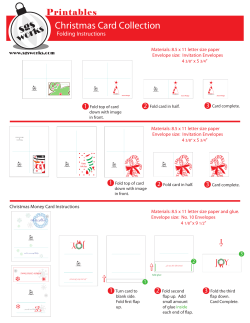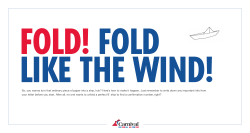
PAGE SAMPLE Express Lapbook Underground Railroad
J L Any Age A T Underground Railroad E Express Lapbook SA M PL E PA G Mini Lapbook, Study Guide Page, Web Links, and Activities A Journey Through Learning www.ajourneythroughlearning.com Copyright 2013 A Journey Through Learning 1 Authors-Paula Winget and Nancy Fileccia Copyright © 2013 A Journey Through Learning E Pages may be copied for other members of household only. For group use, please see our website to purchase a classroom/co-op license. PA G Please check our website at: www.ajourneythroughlearning.com PL E While you are there, sign up for our email newsletter and receive a FREE lapbook! You’ll also receive great discount codes, special offers, find out what’s new and what’s to come! SA M Join us on Facebook! Clipart is from www.clipart.com with permission Copyright 2013 A Journey Through Learning 2 Things to Know Hotdog Fold-Fold vertically Hamburger Fold-Fold horizontally Dotted Lines-These are the cutting lines. Accordion Fold-This fold is like making a paper fan. Fold on the first line so that title is on top. Turn over and fold on next line so that title is on top again. Turn over again and fold again on the next line so that title is on top. Continue until all folds are done. E Cover Labels-Most of the booklets that are folded look nicer with a label on top instead of just a blank space. They will be referred to as “cover label.” This placement key tells you the template goes in the first folder at the top of the left flap. E PA Folder 1 G How do I know where to place each template in the folder? Original fold line PL Folding a Lapbook Base SA M Gather the number of folders required for the project. Fold them flat as seen here. For each folder, fold the left and right sides inward toward the original line to create two flaps. Crease so that the highest part of each flap is touching the original line. It is important not to let the two flaps overlap. You may want to take a ruler and run it down each crease to make it sharper. Copyright 2013 A Journey Through Learning Highest part of flap. 3 Timeline E Food Eaten Along the Way Terminology Used PA G What is a “REAL” railroad? Harriet Tubman Diet Qualities SA M PL E Free or Slave State? Copyright 2013 A Journey Through Learning 4 Complete the Scene Cut out the scene on the dotted line. Glue on to the back of your lapbook. Inside of the suitcase, pack the things that a runaway slave may have taken with them. SA M PL E PA G E Underground Railroad Copyright 2013 A Journey Through Learning 5 Running for Freedom- The Underground Railroad SA M PL E PA G E The Underground Railroad was a means of escape for slaves from 1830 to 1860. Many of the slaves were trying to flee their owners and relocate to the North for freedom. Even though it was called “The Underground Railroad,” it was not a railroad at all. It was a secret path of travel that may have included walking, boats, horse carriages, or hiding for days in abandoned barns. Harriet Tubman was a runaway slave from Maryland. Over the course of 10 years, Harriet helped to lead hundreds of slaves to freedom using this route. Travel on the Railroad held many dangers for the slaves, and for the individuals who helped them escape. Some of these dangers included being caught. When slaves were caught, they were usually severely punished. Other dangers were wild animals, poisonous snakes, and hunger. While running away, many slaves lived on very little food. Because they did not possess anything, they did not take anything with them. They would eat whatever they could find along the way-nuts, roots, corn, apples, or fish caught in streams. The Railroad, and everything about it, had to remain a secret. Along the way, many signals were invented to let slaves know the route to follow. Some of the codes included: special knocks on windows, leaving ashes in certain shapes on the ground, bird sounds, and painted bricks on chimneys. Many families along the trail had secret compartments in their homes and businesses to hide slaves. Many people helped with the Underground Railroad. Most were from the North, but some Southerners also felt that slavery was wrong. Most of the people were ordinary people like doctors, lawyers, store owners, children, and mothers. No one actually knows how many slaves actually escaped, but the numbers are around 100,000. Due to the secrecy of the railroad, no true records were kept. Copyright 2013 A Journey Through Learning 6 1830 1840 E PL SA M E G 1850 PA Timeline Folder 1 7 Copyright 2013 A Journey Through Learning Cut out booklet as one piece. Fold the back bottom section up in back, and then fold the flaps back and glue to make a pocket. Cut out the timeline strip. Fold and store in pocket. Directions: On the timeline, enter other events that were going on in history during this time. Hamburger fold 1860 Folder 1 SA M PL E Was the Underground Railroad an actual railroad? PA G E Fold your paper in half. Cut around the shape. DO NOT CUT ON FOLD. Glue into lapbook. Directions: Answer the question inside the booklet. Copyright 2013 A Journey Through Learning 8 Folder 1 Cut out the booklet. Glue into lapbook. Directions: Using the key provided, shade the areas on your map. http://www.nps.gov/nr/travel/underground/routes.htm PL E PA G E Free or Slave State? SA M Light tan—Free States—Slavery prohibited Green------Slave State---Slavery Allowed Brown------Territories where slavery was permitted by local decision. Red lines—Escape routes Copyright 2013 A Journey Through Learning 9
© Copyright 2025















